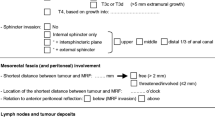Abstract
Purpose
To determine the 1-year progression-free survival (PFS) of extramural venous invasion (EMVI), detected with contrast-enhanced multiple-row detector computed tomography (ceMDCT), in patients with stage III gastric cancer.
Methods
Between January 2009 and December 2013, 117 patients with pathological-proved stage III gastric cancer based on the criteria of the AJCC 7th were included in this retrospective study. All patients underwent adjuvant chemotherapy postoperatively and had been monitored with the follow-up chest/abdomen/pelvis ceMDCT on 3, 6, and 12 months post-operation. Two radiologists reviewed preoperative images regarding the presence of EMVI, categories of tumor and categories of lymph node. Conventional prognostic histological factors including pathological T/N status, tumor location/growth pattern, histological type/tumor differentiation, and tumor size were also recorded. Disease progression was defined as the presence of radiological or/and pathology-confirmed metachronous metastases, local recurrence, or gastric cancer-related death. The 1-year PFS for both EMVI-positive and EMVI-negative was calculated using the Kaplan–Meier product limit. Hazard ratios for 1-year PFS were generated using a Cox proportional hazard regression on ceMDCT tumor characteristics.
Results
The prevalence of EMVI detected with ceMDCT was 43.6% (51/117) in patients with stage III gastric cancer. The EMVI-positive patients had significantly lower 1-year PFS rates (45.1%), than the EMVI-negative patients (75.8%), (Log-rank test, P = 0.0008). In a Cox proportional hazards regression analysis, EMVI and tumor location/growth pattern were identified as independent prognostic factors of 1-year PFS with hazard ratio of 2.272 (95% CI 1.133–4.556, P = 0.021) and 1.982 (95% CI 1.040–3.780, P = 0.039), respectively.
Conclusion
EMVI status, detected with ceMDCT, could be used to counsel patients regarding ongoing risks of metastatic disease, implications for surveillance, and systemic chemotherapy.




Similar content being viewed by others
References
Sasako M, Inoue M, Lin JT, et al. (2010) Gastric Cancer Working Group report. Jpn J Clin Oncol 40(Suppl 1):i28–i37
Jemal A, Siegel R, Xu J, et al. (2010) Cancer statistics, 2010. CA Cancer J Clin 60(5):277–300
Sadeghi B, Arvieux C, Glehen O, et al. (2000) Peritoneal carcinomatosis from non-gynecologic malignancies: results of the EVOCAPE 1 multicentric prospective study. Cancer 88(2):358–363
Edge SB, Compton CC (2010) The American Joint Committee on Cancer: the 7th edition of the AJCC cancer staging manual and the future of TNM. Ann Surg Oncol 17(6):1471–1474
Rivera F, Vega-Villegas ME, Lopez-Brea MF (2007) Chemotherapy of advanced gastric cancer. Cancer Treat Rev 33(4):315–324
Kim JW, Shin SS, Heo SH, et al. (2015) The role of three-dimensional multidetector CT gastrography in the preoperative imaging of stomach cancer: emphasis on detection and localization of the tumor. Korean J Radiol 16(1):80–89
Allum WH, Griffin SM, Watson A, et al. (2002) Guidelines for the management of oesophageal and gastric cancer. Gut 50(Suppl 5):v1–v23
Hunter CJ, Garant A, Vuong T, et al. (2012) Adverse features on rectal MRI identify a high-risk group that may benefit from more intensive preoperative staging and treatment. Ann Surg Oncol 19(4):1199–1205
Grigoryeva ES, Cherdyntseva NV, Karbyshev MS, et al. (2013) Expression of cyclophilin A in gastric adenocarcinoma patients and its inverse association with local relapses and distant metastasis. Pathol Oncol Res 20(2):467–473
Tan CH, Vikram R, Boonsirikamchai P, et al. (2011) Extramural venous invasion by gastrointestinal malignancies: CT appearances. Abdom Imaging 36(5):491–502
Zurleni T, Gjoni E, Ballabio A, et al. (2013) Sixth and seventh tumor-node-metastasis staging system compared in gastric cancer patients. World J Gastrointest Surg 5(11):287–293
Foo M, Leong T (2014) Adjuvant therapy for gastric cancer: current and future directions. World J Gastroenterol 20(38):13718–13727
Kim JW, Shin SS, Heo SH, et al. (2012) Diagnostic performance of 64-section CT using CT gastrography in preoperative T staging of gastric cancer according to 7th edition of AJCC cancer staging manual. Eur Radiol 22(3):654–662
Seevaratnam R, Cardoso R, McGregor C, et al. (2012) How useful is preoperative imaging for tumor, node, metastasis (TNM) staging of gastric cancer? A meta-analysis. Gastric Cancer 15(Suppl 1):S3–S18
Shah MA, Khanin R, Tang L, et al. (2011) Molecular classification of gastric cancer: a new paradigm. Clin Cancer Res 17(9):2693–2701
Landis JR, Koch GG (1977) The measurement of observer agreement for categorical data. Biometrics 33(1):159–174
Castonguay MC, Li-Chang HH, Driman DK (2014) Venous invasion in oesophageal adenocarcinoma: enhanced detection using elastic stain and association with adverse histological features and clinical outcomes. Histopathology 64(5):693–700
Inada K, Shimokawa K, Ikeda T, et al. (1990) The clinical significance of venous invasion in cancer of the stomach. Jpn J Surg 20(5):545–552
Bugg WG, Andreou AK, Biswas D, et al. (2014) The prognostic significance of MRI-detected extramural venous invasion in rectal carcinoma. Clin Radiol 69(6):619–623
Betge J, Pollheimer MJ, Lindtner RA, et al. (2012) Intramural and extramural vascular invasion in colorectal cancer: prognostic significance and quality of pathology reporting. Cancer 118(3):628–638
Chand M, Bhangu A, Wotherspoon A, et al. (2014) EMVI-positive stage II rectal cancer has similar clinical outcomes as stage III disease following pre-operative chemoradiotherapy. Ann Oncol 25(4):858–863
Crosby T (2008) Scottish Intercollegiate Guidelines Network (SIGN) 87–the management of oesophageal and gastric cancer. Clin Oncol (R Coll Radiol) 20(7):528–529
Sternberg A, Amar M, Alfici R, et al. (2002) Conclusions from a study of venous invasion in stage IV colorectal adenocarcinoma. J Clin Pathol 55(1):17–21
Author information
Authors and Affiliations
Corresponding author
Ethics declarations
Conflict of interest
All of authors have no conflict of interest.
Ethical standard
All procedures performed in studies involving human participants were in accordance with the ethical standard of the institutional and/or national research committee and with the 1964 Helsinki declaration and its later amendments or comparable ethical standards.
Informed consent
Informed consent was obtained from all individual participants included in the study.
Rights and permissions
About this article
Cite this article
Cheng, J., Wu, J., Ye, Y. et al. The prognostic significance of extramural venous invasion detected by multiple-row detector computed tomography in stage III gastric cancer. Abdom Radiol 41, 1219–1226 (2016). https://doi.org/10.1007/s00261-015-0627-1
Published:
Issue Date:
DOI: https://doi.org/10.1007/s00261-015-0627-1




